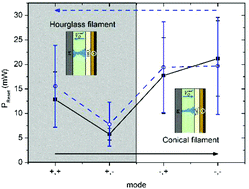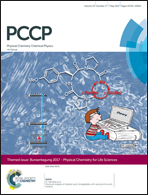Voltage-polarity dependent multi-mode resistive switching on sputtered MgO nanostructures†
Abstract
Resistive switching in metal–insulator–metal nanosctructures is being intensively studied for nonvolatile memory applications. Here, we report unipolar resistive switching in Pt/MgO/Ta/Ru structures, with a 30 nm oxide barrier. A forming process was needed to initiate the resistive switching, which was then observed for all Set and Reset voltage polarity combinations. We studied the influence of the voltage polarity on the variability of the Set/Reset voltages and ON/OFF resistances and revealed the importance of a thin TaOx layer working as an oxygen revervoir for resistive switching. The mechanism behind this phenomenon can be understood in terms of conductive filaments formation/rupture with a contribution from Joule heating. Resistance change is thus caused by a voltage-driven oxygen vacancy motion in the MgO layer and a filament model was proposed for each polarity mode. A OFF/ON resistance ratio of at least 2 orders of magnitude was obtained with resistive states stable up to 104 s. Our results open the prospect to improve switching performance in other resistive switching systems, by proving a better understanding of the differences between operation modes.



 Please wait while we load your content...
Please wait while we load your content...